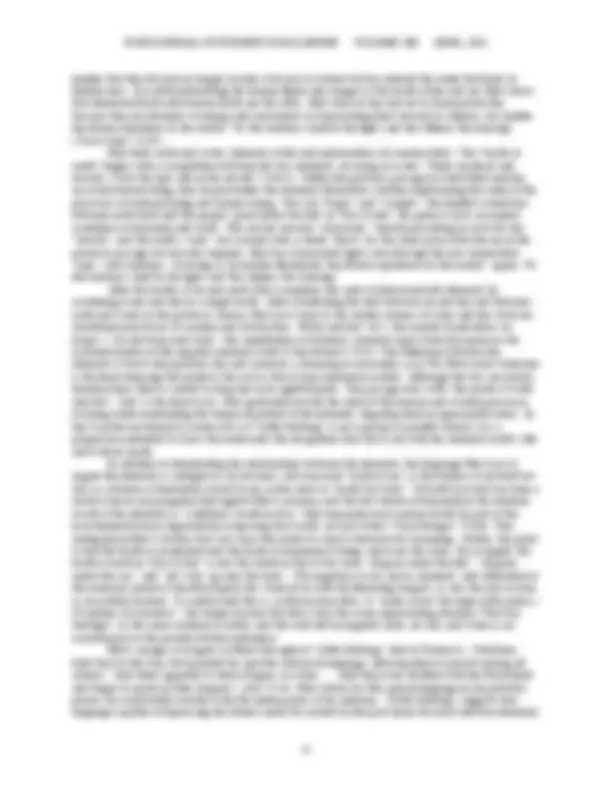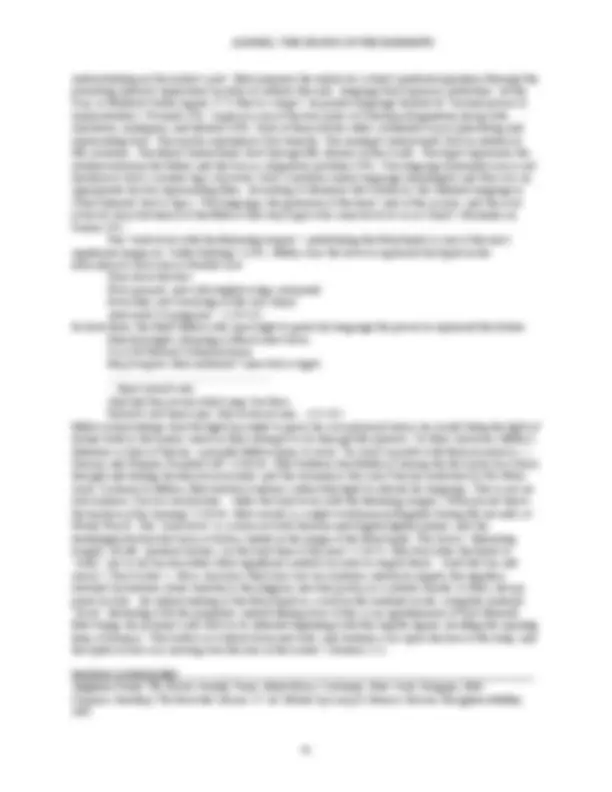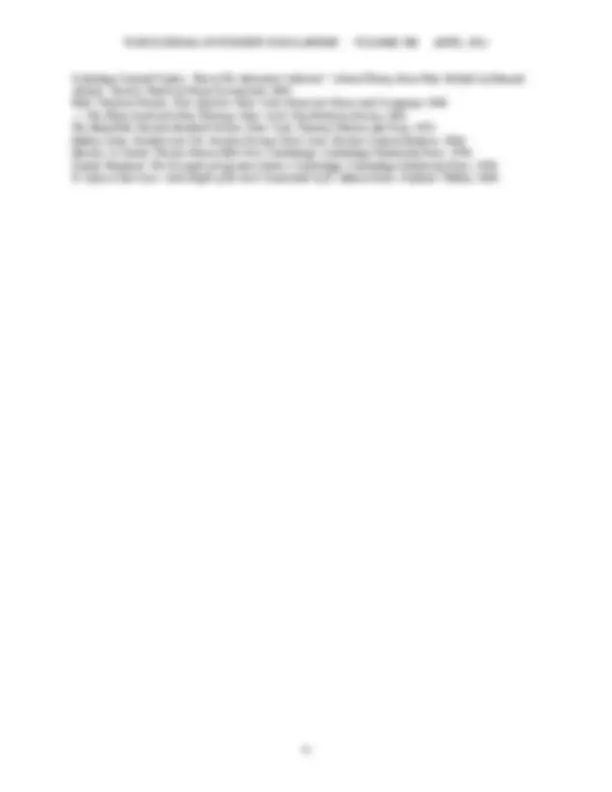





Study with the several resources on Docsity

Earn points by helping other students or get them with a premium plan


Prepare for your exams
Study with the several resources on Docsity

Earn points to download
Earn points by helping other students or get them with a premium plan
Community
Ask the community for help and clear up your study doubts
Discover the best universities in your country according to Docsity users
Free resources
Download our free guides on studying techniques, anxiety management strategies, and thesis advice from Docsity tutors
In this document, Adam Engel explores T.S. Eliot's poetics of logism, or the use of language to facilitate the reader's experience of divinity. Eliot, influenced by Maximus the Confessor's belief that divinity is the ultimate language, employs the symbols of air, earth, fire, and water to lead readers to an understanding of reality as the 'darkness of God.' Through the negation of these material symbols, Eliot argues that humanity reaches reality only through material suffering and death. The document also discusses Eliot's journey towards gaining the confidence to universalize the hope of mankind and experience reality directly.
What you will learn
Typology: Study notes
1 / 5

This page cannot be seen from the preview
Don't miss anything!




Author: Adam Engel
Faculty Sponsor: David Venturo Department of English
Maximus the Confessor claims that divinity is the ultimate language: “The language, the grammar of the heart ... is that very Logos who came down to us as Christ” (Maximus in Parker 179). For T. S. Eliot, poetry‟s function is to facilitate the reader‟s experience of reality. Eliot, a convert to Anglicanism, maintains that reality is divinity. This presents a problem: if nothing material can perfectly represent divinity, how then can language, a material set of symbols, perform this function? Blanford Parker describes writers‟ attempts to solve this problem as logism ( Triumph 178). Eliot is a logist: to prepare the reader to experience divinity, he develops the symbolic significance of air, earth, fire, and water. These material symbols play important roles throughout The Waste Land and Four Quartets , but in “Little Gidding,” the last of the Quartets , Eliot negates them. By invoking, developing, and negating these material symbols, Eliot leads the reader to understand reality as the darkness left in the wake of the world: the “darkness of God” (“East Coker”). For Eliot, poetry serves its function through its final negation, and humanity reaches reality only through material suffering and death. By personifying each element as it dies in “Little Gidding,” Eliot argues that the end of the elements is the end of humanity, but also the beginning of an experience of reality: “In my end is my beginning” (“East Coker”). This negative language is Eliot‟s logism, his attempt to replicate the expressive power of the creative word.
Samuel Taylor Coleridge argues that a symbol is a temporal object which points toward eternal divinity ( Statesman’s Manual). To T. S. Eliot, the material world is a symbol in the Coleridgean sense: it points toward reality understood as Christian divinity. Poetry, composed of material language, is part of the physical world and thus cannot perfectly express divinity. Eliot invokes material symbols, develops them thematically, and then denies them in order to affirm the supremacy of the metaphysical. In this way, he ultimately denies poetry itself. The emptiness Eliot leaves in the wake of his denied symbols is "the darkness of God,” reality ("East Coker"). By using language to facilitate the reader‟s experience of divinity, Eliot practices a poetics of logism as described by Blanford Parker: he solves the problem of representing God the Father‟s relationship to the Son, the creative word or logos , through language ( Triumph 178).
In “Little Gidding,” the last of the Four Quartets , Eliot reaches the finale of a Dantean spiritual journey. The poet begins in The Waste Land , where Eliot introduces his central themes and starts to navigate the stages of his personal crisis. Unlike Dante, Eliot does not embark with a clear destination. He does not craft an alter ego to function as a character in his narrative; rather, Eliot the poet undergoes the very same agonies and discoveries expressed in The Waste Land. Indeed, as A. David Moody argues, the poem itself is lyrical: Eliot manifests his personal suffering, including a painfully unhappy marriage, through the spiritually dead vampires and their empty sensuality in the Unreal City. He universalizes this suffering, though this impersonalization did not become his conscious goal until “Burnt Norton.” One feature remains consistent throughout Eliot‟s work: he never seeks salvation on earth. After transcending Tiresias‟s dead vision, coming to terms with sensuality through the Thames daughters, undergoing purgative death by water, and witnessing the destruction of language and the world in “What the
Thunder Said,” Eliot gains the confidence to universalize what he regards as the hope of mankind and the means of experiencing reality directly. By the time he wrote “East Coker” and decided to make “Burnt Norton” into the first of a series of four poems, Eliot had left behind his uncertainty and become sovereign over his own journey; as Virgil crowns Dante on the top of the mountain of Purgatory before vanishing, so Eliot gains authority over the direction of his own text during the Quartets. These poems demand that the reader assume Dante‟s role, allowing Eliot to become a Virgil, or, more appropriately, a St. Bernard, guiding the reader to the mystic experience at the journey‟s end. The reader undergoes this experience in “Little Gidding.” The last Quartet begins with vivid descriptions of contradictory seasons: “Midwinter spring is its own season” (1.1). This recalls the first line of The Waste Land : “April is the cruelest month.” The surprising corruption of Chaucer‟s imagery from The Parliament of Fowles has been transformed into a confident, resolved expression of an impossible truth. Cruel “April” suggests an unwanted, painful return to life, the reincarnation of a cycle that should not continue. Cruelty contained within spring seems contradictory, but the desolation of modern life contrasted with the spiritual richness of Chaucer‟s time becomes apparent as The Waste Land progresses. “Midwinter spring” expresses the opposite: a bastion of life in a bleak landscape. If time is suffering (“East Coker”), and timelessness intersects time in every moment (“The Dry Salvages”), then this oasis is constantly accessible. Eliot‟s contradictory seasonal images, which reject material constraints, are a mystical experience; “spring” within “Midwinter” offers a spiritual oasis. The constantly accessible spiritual oasis within time, a state of being that is “its own season,” echoes the saint‟s perpetual intent on the divine in “The Dry Salvages.” Eliot now takes the reader from the “right action,” the saint‟s activity, to the end of this action, experience of Eliot‟s reality. This link between The Waste Land ‟s beginning and the end of Eliot‟s odyssey reflects St. John of the Cross‟s via negativa ; suffering throughout the work was necessary to reach this point, just as the material world and poetry are significant to Eliot because they must exist in order to be negated. In “Little Gidding,” the Quartet of fire, the consequence of agony and patience is finally apparent. “I saw a light that was a river flowing / light within light between enameled banks / painted with blossoms of miraculous spring” (Alighieri 30.61-3). So Dante describes the Empyrean and the river of light he finds upon his final ascension. Beatrice explains the limited nature of this vision: “„The flame of high desire that makes you yearn / for greater knowledge of these things you see / pleases me more the more I see it burn. / ... The river and the jewels you see / dart in and out of it, and the smiling flowers / are dim foretastes of their reality‟” (30.70-9). Eliot intends the spiritual exercises in the previous Quartets to prepare the reader to experience reality; just as Dante must pass through a wall of fire to reach the Earthly Paradise, so the reader must undergo a final cleansing in order to understand the goal of Eliot‟s narrative. This takes place during the opening of the second section in which the reader witnesses the “death” of air, earth, water, and fire (2.56-79). These elements, material symbols that have been thematic pillars supporting Eliot‟s work, are finally negated. This negation is perhaps more significant than the negation of language in “What the Thunder Said”; though words are the building blocks of poetry, the elements may be seen (figuratively) as the building blocks of reality as we know it. By invoking, developing, and removing these symbols, Eliot prepares the reader to accept the divine truth waiting: the fusion of the purgative fire and the divine rose (5.261). Even this end can only be expressed symbolically, since Eliot‟s poetry does not give the reader perfect experience but a path to reach it. However, by calling the reader‟s attention to the negation of all material and the supremacy of the divine, Eliot sets the reader on what he considers the right path to true life. The three stanzas in which Eliot finally eliminates his elemental symbols illustrate the special connections between individual elements as they simultaneously complete the function of the elements as a group. The “death of air” begins with an image of “Ash on an old man‟s sleeve” and moves to “Dust in the air suspended” (2.56-8). Ash implies a past fire, and the dust that remains after this hinted destruction is now in the realm of air. This air is not a lively wind but a stagnant force in which the dust is “suspended.” The spent fire and the lethargic air parallel the state of the “old man.” The context suggests that he is either dead from the passage‟s beginning or dies by its end: the remains in the stagnant air signify “the place where a story ended,” and “Dust inbreathed was a house” suggests that the house, a function of vital breath, is a thing of the past. Finally, the “death of hope and despair”
understanding on the reader‟s part. Eliot prepares the reader for a direct spiritual experience through the preceding Quartets ‟ injunctions in order to achieve this end: language that expresses perfection. In this way, as Blanford Parker argues, T. S. Eliot is a logist: he pushes language beyond its “normal power of representation” ( Triumph 178). Logism is one of the four poles of Christian imagination along with mysticism, analogism, and fideism (194). Each of these modes offers a different way of perceiving and representing God. The mystic experiences God directly. The analogist understands God in relation to His creatures. The fideist understands God through His absence in the world. The logist represents the relation between the Father and the Son as a linguistic problem (178). The language humanity uses is not identical to God‟s creative logos ; however, God‟s existence makes language meaningful, and thus it is an appropriate tool for representing Him. According to Maximus the Confessor, the ultimate language is Christ himself; God is logos : “The language, the grammar of the heart, and of the cosmos, and the soul (even its very substance) of the Bible is that very Logos who came down to us as Christ” (Maximus in Parker 179). The “dark dove with the flickering tongue,” symbolizing the Holy Spirit, is one of the most significant images in “Little Gidding” (2.83). Milton uses the dove to represent the Spirit in the invocation to book one of Paradise Lost : Thou from the first Wast present, and with mighty wings outspread Dove-like satst brooding on the vast Abyss And mad'st it pregnant ... (1.19-22) In book three, the blind Milton calls upon light to grant his language the power to represent the divine: Hail holy light, offspring of Heav'n first-born, Or of th' Eternal Coeternal beam May I express thee unblam'd? since God is light, .................................................................. ... thee I revisit safe, And feel thy sovran vital Lamp; but thou Revisit'st not these eyes, that rowle in vain ... (3.1-23) Milton acknowledges that the light has failed to grace his own physical vision; he would bring the light of divine truth to the reader, much as Eliot attempts to do through the Quartets. To Eliot, however, Milton‟s blindness is that of Tiresias, a prophet Milton hopes to rival: “So were I equal'd with them in renown, / ... Tiresias and Phineus Prophets old” (3.34-36). Eliot believes that Milton is among the first poets for whom thought and feeling became disassociated, and this disunity is the crisis Tiresias embodies in The Waste Land. Contrary to Milton, Eliot invokes darkness rather than light to elevate his language. This is not an evil darkness, but it is destructive: “After the dark dove with the flickering tongue / Had passed below the horizon of his homing” (2.83-4). Eliot served as a night watchman in England during the air raids of World War II. The “dark dove” is a vision of both German and English fighter planes, and the terrifyingly destructive force of both is united in the image of the Holy Spirit. The dove‟s “flickering tongue” recalls “pentecostal fire / in the dark time of the year” (1.10-1). Eliot describes the Spirit as “dark,” just as he has described other significant symbols in order to negate them: “dark the sun and moon” (“East Coker”). Now, however, Eliot does not use darkness merely to negate; the negation invoked by darkness leads directly to the religious aim that poetry as a symbol should, to Eliot, always point toward. An understanding of the Holy Spirit as a void in the material world, a negated material “dove,” flickering with the purgative, universalizing force of fire, is an apprehension of God Himself. Eliot brings his journey‟s end back to its ultimate beginning with this logistic figure, recalling the opening lines of Genesis: “The earth was without form and void, and darkness was upon the face of the deep; and the Spirit of God was moving over the face of the waters” (Genesis 1.2).
Alighieri, Dante. The Divine Comedy. Trans. Mark Musa. 3 volumes. New York: Penguin, 2003. Chaucer, Geoffrey. The Riverside Chaucer. 3rd^ ed. Edited by Larry D. Benson. Boston: Houghton Mifflin,
Coleridge, Samuel Taylor. “From The Statesman’s Manuel .” Critical Theory Since Plato. Edited by Hazard Adams. Boston: Harcourt Brace Jovanovich, 2005. Eliot, Thomas Stearns. Four Quartets. New York: Harcourt, Brace and Company, 1943. ---. The Waste Land and Other Writings. New York: The Modern Library, 2002. The Holy Bible: Revised Standard Version. New York: Thomas Nelson and Sons, 1952. Milton, John. Paradise Lost. Ed. Gordon Teskey. New York: Norton Critical Editions, 2004. Moody, A. David. Thomas Stearns Eliot Poet. Cambridge: Cambridge University Press, 1994. Parker, Blanford. The Triumph of Augustan Poetics. Cambridge: Cambridge University Press, 1998. St. John of the Cross. Dark Night of the Soul. Translated by E. Allison Peers. Radford: Wilder, 2008.